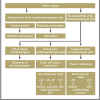The treatment of hallux valgus
- PMID: 23267411
- PMCID: PMC3528062
- DOI: 10.3238/arztebl.2012.0857
The treatment of hallux valgus
Abstract
Background: Hallux valgus is the commonest forefoot deformity, with an estimated prevalence of 23% to 35%. It causes symptoms on the medial edge of the foot, the sole, and the small toes. Non-operative treatment may alleviate symptoms but does not correct the deformity of the big toe. Surgery is indicated if the pain persists. The correct operation must be selected from a wide variety of available techniques.
Methods: In this article, we selectively review the pertinent literature, including the recommendations of medical societies in Germany and abroad, in the light of our own clinical experience.
Results: There have been many clinical trials of various treatments for hallux valgus, but very few of these were randomized, and the case numbers were generally small. Mild deformities are best treated by distal first metatarsal osteotomies, e.g. the Chevron osteotomy. Severe deformities require a soft-tissue procedure at the first metatarsophalangeal joint and a proximal first metatarsal osteotomy. In case of osteoarthritis, and in elderly patients, a resection arthroplasty is preferred; arthrodesis is performed in physically active patients. After correction of hallux valgus, patients can usually bear their full weight on the treated foot while wearing a flat surgical shoe. Proper surgical treatment results in a good or very good outcome in 85% of patients and a satisfactory result in a further 10%.
Conclusion: The clinical outcome of present treatments seems to be good in most cases, but large-scale randomized trials are still needed to verify the efficacy of the wide variety of operations and fixation techniques that are currently being offered.
Figures







Comment in
-
High heels as a cause.Dtsch Arztebl Int. 2013 Apr;110(17):296. doi: 10.3238/arztebl.2013.0296. Dtsch Arztebl Int. 2013. PMID: 23671477 Free PMC article. No abstract available.
References
-
- Wülker N. Hallux valgus - Hallux rigidus. Stuttgart: Enke. 1997:3–32.
-
- Mann RA, Coughlin MJ. Hallux valgus: etiology, anatomy, treatment and surgical considerations. Clin Orthop. 1981;157:31–41. - PubMed
-
- Perera AM, Mason L, Stephens MM. The pathogenesis of hallux valgus. J Bone Joint Surg Am. 2011;93:1650–1661. - PubMed
MeSH terms
LinkOut - more resources
Full Text Sources
Other Literature Sources
Medical
